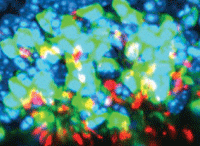Blind mice can see again, thanks to a stem cell rebuilding process developed by researchers at the University of Oxford in the UK.

Re-formed outer retinal photoreceptor cells are shown in green. Image: University of Oxford
Using a mouse model of severe human retinitis pigmentosa at a stage when no host rod cells remain, the researchers transplanted rod precursor stem cells to recreate a brand new outer nuclear layer. After just two weeks, the photoreceptor cells had been restored and the mice could see.
“We have shown the transplanted cells survive, they become light-sensitive, and they connect and reform the wiring to the rest of the retina to restore vision,” says lead author Robert MacLaren, DPhil, FRCS, FRCOphth.
Singh MS, Charbel Issa P, Butler R, et al. Reversal of end-stage retinal degeneration and restoration of visual function by photoreceptor transplantation. Proc Natl Acad Sci USA. 2013 Jan 3. [Epub ahead of print]

